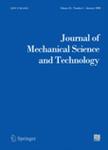版权所有:内蒙古大学图书馆 技术提供:维普资讯• 智图
内蒙古自治区呼和浩特市赛罕区大学西街235号 邮编: 010021

作者机构:Seoul Natl Univ Sch Mech & Aerosp Engn Seoul 151742 South Korea BK21 Sch Creat Engn Design Next Generat Mech & Ae Seoul 151742 South Korea Soongsil Univ Dept Mech Engn Seoul 156743 South Korea Seoul Natl Univ Technol Seoul 139743 South Korea
出 版 物:《JOURNAL OF MECHANICAL SCIENCE AND TECHNOLOGY》 (韩国机械工程师学会国际杂志)
年 卷 期:2008年第22卷第9期
页 面:1757-1764页
核心收录:
基 金:Brain Korea 21 Project Ministry of Science Technology
主 题:active magnetic bearing self-sensing phase modulation position sensor feedback controller pulse width modulation(PWM) signal processing algorithm position estimator
摘 要:Conventional AMB(active magnetic bearings) systems consist of electromagnetic coils, position sensors, power amplifiers and a feedback controller. This hardware configuration can lead to a structural complexity, problems of space limitations for the installation, and position control difficulties due to the non-collocation of actuators and sensors. In this paper, a self-sensing mechanism is proposed to resolve Such limitations of the general AMB system. The proposed self-sensing scheme uses a phase difference of the injected current of two opposite electromagnetic actuators while an object is levitating between the actuators. The relationship between the phase difference of injected currents and the position of a levitated object was theoretically derived and linearized. In order to realize the proposed self-sensing scheme, a signal processing algorithm was developed. The frequency response of the estimator was measured to verify, the performance of the proposed self-sensing scheme. In addition, a magnetic levitation and a disturbance rejection response were experimentally obtained to verify the feasibility of the proposed self-sensing mechanism. Experimental results showed that the developed self-sensing technique has similar performance as a practical gap sensor.